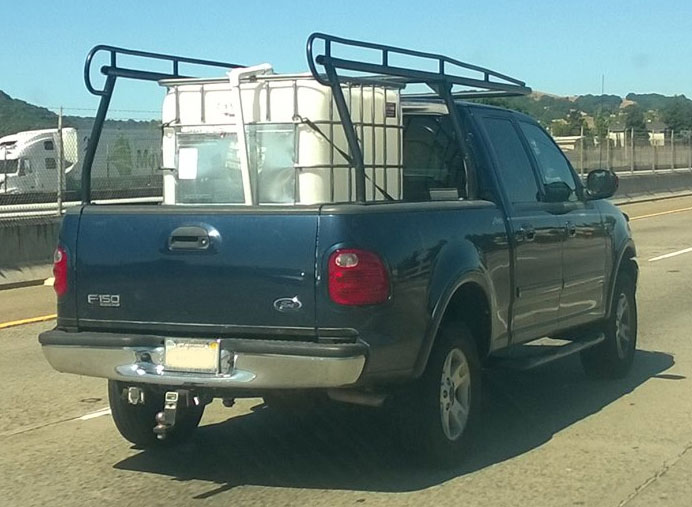In the last post, the safety hazards associated with driving with a half full IBC Tote were looked at. A full tote, weighs 2600 pounds and has very little to no sloshing, except when taking corners, the mass of the water will work to pull your vehicle over. This was experienced by a passenger in an F350 carrying 275 gallons of water.
When a tote is half full, there is about 1250 pounds of water that moves, so when you turn left, that water moves with considerable momentum to the right. If physics calculations were performed we could figure out how much force is being applied to a vehicle at any given speed if we knew the mass.
Lets call this mass of water moving in a tank as slosh. How can you minimize slosh in an IBC tote?
If you notice in the video above, there is a gap between the top of the water and the top of the tank in when its considered “full” and when its half full. If we can decrease the size of that open space in a half full tank then we could work to minimize the “slosh” in the tank. Right?
Tank Baffles
In almost all tanker trucks you see on the road, they have baffles inside them. These have been designed to break up water sloshing through a tank. IBC Totes don’t have them. In theory, you could build a structure in your tank using baffles made of plywood. Keep in mind, your access hole is only 6″ in diameter so your boards will have to be cut to fit together. Then its sort of like building a “Ship in a bottle” from there.
In an elliptical tank, a baffle sits in the middle and allows water to go by it. Like in the picture to the left. If you could build something similar, that won’t break when water hits it, nor will shred in your tank and possibly plug your discharge lines and pumps, then you’ll be good to go!
Wiffle Balls
Chances are, you played with these plastic baseballs as a kid. They come in an assortment of colors and costs, but the functionality is the same.
Buy enough wiffle balls to fill your tote. Water slosh will, in theory, be broken up by the wiffle balls. Plus, if there are holes around the entire wiffle ball, it should also drain when you empty it. Try to stay away from the balls that are half cups as water will not drain out of those.
Is this really an economical solution? Not unless you have a thousand wiffle balls laying around. You’re probably better off buying the right sized tank for your trucks holding capacity than filling an IBC Tote with wiffle balls.
Ball Pit Balls
The goal with ball pit balls is to take up the space at the top of the tote. Ball pit balls should float. The trick here is to fill your tote half full, then dump how every many you need to fill the top half with these plastic ball pit balls.
Assuming your tote is half full, there is about 2 feet of space between the top of the water and top of the tote. Totes measure about 40″ wide, so you’ll need about 2500 ball pit balls to take up that extra space. The cheapest volume of these balls is 1,000 for $179.99. Again, still more economical to buy a tank that has baffles in it, or holds the volume that matches the carrying capacity of your vehicle.
Beach Balls

Beachball
This idea came from an area fill station as they’ve received reports from their local Police Department that the users of the fill station are overloading the vehicle payload capacity. There haven’t been any citations yet, as the local PD is just beginning to educate themselves on the weight of water and the dangers of an overloaded vehicle. So here’s the idea.
Deflate a beach ball and insert into the lid of the tank. Grab an air compressor and fill it up. Now you’ve got a full beach ball in your tank. Grab 3-4 of them and do the same. The top section of your tank should now be full of beach balls which will in essence be a perfect fit for your needs. Plus, beach balls are cheap and lightweight. You can buy a 12 pack of them on Amazon for $8.
What’s the final take away?
The best answer is obviously to size your tote to your vehicles capacity. Unfortunately, until law enforcement issues enough citations to make people rethink the 300 gallon totes, there won’t be much demand for smaller totes. If we can shift that demand, the first person to start selling 150 and 200 gallon totes is going to make a ton of money.
If you’re unsure of your vehicle payload capacity, this chart was made for 2015 models. Definitely a good starting point, but your best option is to look in your owners manual to figure out what your vehicle can support.







Leave a Reply